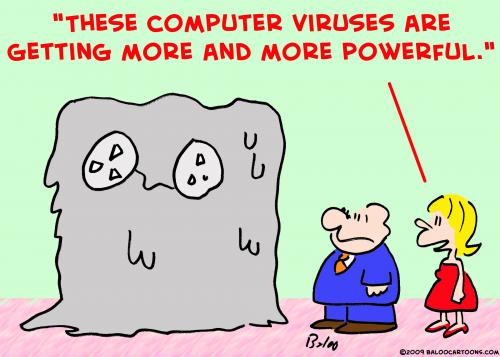Viruses can increase their chances of spreading to other computers by infecting files on a network file system or a file system that is accessed by another computer.
As stated above, the term "computer virus" is sometimes used as a catch-all phrase to include all types of malware, even those that do not have the reproductive ability. Malware includes computer viruses, computer worms, Trojan horses, most rootkits, spyware, dishonest adware and other malicious and unwanted software, including true viruses. Viruses are sometimes confused with worms and Trojan horses, which are technically different. A worm can exploit security vulnerabilities to spread itself automatically to other computers through networks, while a Trojan horse is a program that appears harmless but hides malicious functions. Worms and Trojan horses, like viruses, may harm a computer system's data or performance. Some viruses and other malware have symptoms noticeable to the computer user, but many are surreptitious or simply do nothing to call attention to themselves. Some viruses do nothing beyond reproducing themselves.
The first academic work on the theory of computer viruses (although the term "computer virus" was not used at that time) was done in 1949 by John von Neumann who held lectures at the University of Illinois about the "Theory and Organization of Complicated Automata". The work of von Neumann was later published as the "Theory of self-reproducing automata". In his essay von Neumann described how a computer program could be designed to reproduce itself.
In 1972 Veith Risak, directly building on von Neumann's work on self-replication, published his article "Selbstreproduzierende Automaten mit minimaler Informations�bertragung" (Self-reproducing automata with minimal information exchange). The article describes a fully functional virus written in assembler language for a SIEMENS 4004/35 computer system.
In 1980 J�rgen Kraus wrote his diplom thesis "Selbstreproduktion bei Programmen" (Self-reproduction of programs) at the University of Dortmund. In his work Kraus postulated that computer programs can behave in a way similar to biological viruses.
In 1984 Fred Cohen from the University of Southern California wrote his paper "Computer Viruses - Theory and Experiments". It was the first paper to explicitly call a self-reproducing program a "virus", a term introduced by Cohen's mentor Leonard Adleman.
An article that describes "useful virus functionalities" was published by J. B. Gunn under the title "Use of virus functions to provide a virtual APL interpreter under user control" in 1984.
The actual term "virus" was first used to denote a self-reproducing program in a short story by David Gerrold in Galaxy magazine in 1969 - and later in his 1972 novel, When HARLIE Was One. In that novel, a sentient computer named HARLIE writes viral software to retrieve damaging personal information from other computers to blackmail the man who wants to turn him off. The Terminal Man, a science fiction novel by Michael Crichton (1972), told (as a sideline story) of a computer with telephone modem dialing capability, which had been programmed to randomly dial phone numbers until it hit a modem that is answered by another computer. It then attempted to program the answering computer with its own program, so that the second computer would also begin dialing random numbers, in search of yet another computer to program. The program is assumed to spread exponentially through susceptible computers. The Creeper virus was first detected on ARPANET, the forerunner of the Internet, in the early 1970s. Creeper was an experimental self-replicating program written by Bob Thomas at BBN Technologies in 1971. Creeper used the ARPANET to infect DEC PDP-10 computers running the TENEX operating system. Creeper gained access via the ARPANET and copied itself to the remote system where the message, "I'm the creeper, catch me if you can!" was displayed. The Reaper program was created to delete Creeper.
As stated above, the term "computer virus" is sometimes used as a catch-all phrase to include all types of malware, even those that do not have the reproductive ability. Malware includes computer viruses, computer worms, Trojan horses, most rootkits, spyware, dishonest adware and other malicious and unwanted software, including true viruses. Viruses are sometimes confused with worms and Trojan horses, which are technically different. A worm can exploit security vulnerabilities to spread itself automatically to other computers through networks, while a Trojan horse is a program that appears harmless but hides malicious functions. Worms and Trojan horses, like viruses, may harm a computer system's data or performance. Some viruses and other malware have symptoms noticeable to the computer user, but many are surreptitious or simply do nothing to call attention to themselves. Some viruses do nothing beyond reproducing themselves.
The first academic work on the theory of computer viruses (although the term "computer virus" was not used at that time) was done in 1949 by John von Neumann who held lectures at the University of Illinois about the "Theory and Organization of Complicated Automata". The work of von Neumann was later published as the "Theory of self-reproducing automata". In his essay von Neumann described how a computer program could be designed to reproduce itself.
In 1972 Veith Risak, directly building on von Neumann's work on self-replication, published his article "Selbstreproduzierende Automaten mit minimaler Informations�bertragung" (Self-reproducing automata with minimal information exchange). The article describes a fully functional virus written in assembler language for a SIEMENS 4004/35 computer system.
 Computer Image Gallery |  first computer virus. |  Computer viruses |  dangerous computer viruses |  spacer, Computer Viruses |
 Computer Viruses (What They |  With this anti-virus software |  myLot - computer virus |  computer viruses 300x244 How |  Computer viruses will |
An article that describes "useful virus functionalities" was published by J. B. Gunn under the title "Use of virus functions to provide a virtual APL interpreter under user control" in 1984.
 Cartoon: computer viruses |  A computer virus is a computer |  computer-virus |  Types of Computer Viruses |  computer viruses |
 viruses |  what is a computer virus |  Computer viruses can be a |  Computer viruses of one kind |  computer virus, |
No comments:
Post a Comment